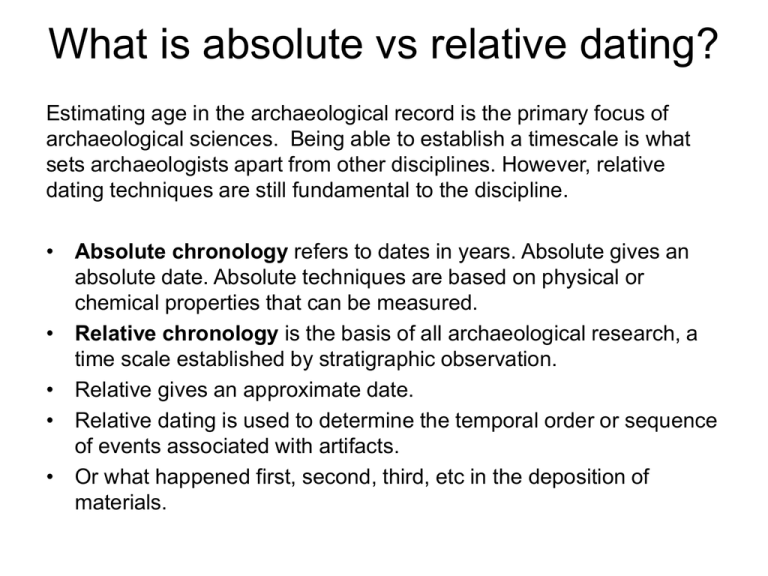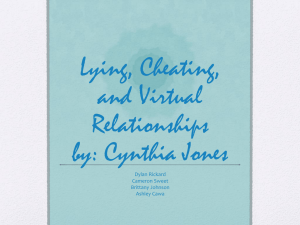Dating Methods PowerPoint
advertisement

What is absolute vs relative dating? Estimating age in the archaeological record is the primary focus of archaeological sciences. Being able to establish a timescale is what sets archaeologists apart from other disciplines. However, relative dating techniques are still fundamental to the discipline. • Absolute chronology refers to dates in years. Absolute gives an absolute date. Absolute techniques are based on physical or chemical properties that can be measured. • Relative chronology is the basis of all archaeological research, a time scale established by stratigraphic observation. • Relative gives an approximate date. • Relative dating is used to determine the temporal order or sequence of events associated with artifacts. • Or what happened first, second, third, etc in the deposition of materials. Relative Dating Methods • Stratigraphy- Archaeological stratification refers to the observed layering of matrices, known as strata layers. • These layers or strata can be well defined by contrasts in color, texture, composition or other characteristics. • Stratified deposits reflect the Law of Superposition which states that the sequence of observable strata, from bottom to top, reflects the order of deposition. • Seriation is the study of attributes that allow an archaeologist to most accurately reconstruct the passage of time. • There are two applications of seriation: – stylistic which is the technique for ordering artifacts and attributes according to similarity in style – And frequency seriation that orders the sequence of sites or deposits by studying the relative frequencies of their artifact types. • • • • A great example of seriation is a work completed by James Deetz and Edwin Dethlefsen in 1966. They chose dated New England colonial gravestones from Stoneham, Massachusetts • Paleontology- used “index” fossils to date associated material remains. – The most useful indicators of age intervals are the remains of organisms which have two characteristics: 1) have a wide geographic distribution and 2) then appear then become extinct over a short period. – A problem with this technique is determining if faunal remains an artifacts are in true association. It is critical to first verify that the artifacts and fossils are in direct relation to one another. Chemical Accumulation- both an absolute and a relative dating technique. Mostly used as a relative dating method because it takes so much effort to calibrate the sample. – Most useful in dating human and animal skeletal remains. – Bone is made of two components 35% organic material (collagen or protein and fat) and 65% inorganic known as hydroxyapetite. – This idea is based on the concept that certain chemicals will build up in an object over time; the more of the chemical found in the material the older the remains. – These techniques are known as FUN techniques (fluorine, uranium, and nitrogen tests). These three elements affect either the organic or hydroxyapetite in varying ways allowing us to measure and gain a relative date. – Three things can be determined: 1) human skeletal remains associated with artifact assemblages 2) human remains associated with extinct faunal remains and 3) if skeletal remains found belong to the same person Absolute Dating Methods • Radiocarbon- The most common method of absolute dating is radiocarbon or c14 dating. This technique was introduced in 1955 by a University of Chicago scientist Willard Libby. – Living creatures regularly absorb c14 as well as c12 throughout that life at a constant rate. – The absorption of c14 ceases at the time of death and begins to decay in what are called “half lives”. – The half life for c14 is 5,730 years. Which means that it takes 5730 years for half of the amount of c14 in an organism to decay. – It takes 5730 for another half of the remaining c14 to decay, etc. So the age can be determined by comparing the proportion of c14 to stable c12. – Radiocarbon dating has revolutionized archaeological dating. – It provided the first means of relating dates and sequences on a worldwide basis. – Yet, we now know that radiocarbon does have deficiencies. We know that this method is only accurate in dating artifacts up to about 50,000 years ago. • Dendrochronology- An absolute method of dating artifacts is through dendrochronology which compares tree growth rings preserved in a site with a tree of known age. – This is achieved when we uncover a tree or a portion of a tree in association with a site or from boards on structures found at archaeological sites, or artifacts manufactured from wooden items. – Developed by A.E. Douglas it is based on the idea that each year a new ring (or row of wood cells) grows. Often used as a check to radiocarbon dating. • Dendrochronology Explained • • • Potassium Argon- half life of K is 1.25 billion best used for rocks that are at least 100,000 yrs (known for successfully dating Pliocene and Pleistocene strata) but can be used to date as early as 50K year ago. – Important archaeological findings dated using K/Ar dating include the sequence at Olduvai Gorge in Tanzania (H habilis) and the remains a Lucy (discovered by Donald Johanson expedition in 1973) discovered in Ethiopia. – Potassium-Argon dating methods make up for the deficiency of radiocarbon dating. – The method using this radioactive counting technique can date artifacts from 50,000 to up to 2 billion years ago. This method picks up where radio carbon dating left off. – This method is based on the radioactive decay of a rare isotope of potassium to form argon gas (the half life of potassium is 1.31 billion years). Argon Argon- same except measuring the Ar/Ar ratio instead of the K/Ar ratio. This method was also useful in dating Lucy as well we the Trinil site in Java where the oldest H Erectus was found Uranium series- uranium is radioactive and is decays into a sequence of other elements at a known rate ending with lead (known as the U series). Piltdown Forgeries …Evolution of Man… 780,000 ya Homo Sapiens • Homo Sapiens • Homo Neandertals • Homo Heidelbergensis 1.8 mya Homo Erectus 2.5 mya Homo Habilis 3-4.4 mya Australopithecus Charles Dawson Raymond Dart • • • • • • • • • • • • • • • • • • Piltdown Timeline 1908-11: Dawson discovers first Piltdown fragments 1912: Dawson contacts Woodward about first skull fragments 1912: Dawson, Woodward form digging team 1912: Team finds molar, skull fragment 1912: Right parietal skull bones and the jaw bone discovered 1912:Arthur Smith Woodward completed an anatomical reconstruction of the remains 1912: Arthur Smith Woodward unveiled Piltdown Man 1913: Anatomist Author Keith acquires casts and does his own reconstruction 1913: Grafton Elliot Smith defended Woodward’s reconstructions 1915: Dawson found a fragment of fossil bone he was certain belonged to a second Piltdown Man. 1924: Dart discovers Australopithecus in Taung South Africa. 1925: Edmonds reports Piltdown geology error. Report ignored. 1930s: Fossils from other parts of the world suggested the brain was not key in evolution 1935: Oakely questions where Piltdown was found & suggests the strata layers did not coincide 1943: Fluorine content test is perfected by Oakley and first proposed 1950: Fluorine content test establishes Piltdown man as relatively recent. 1953: Oakley expose the hoax. 2003: Full extent of Dawson's hoaxes exposed. Questions to Consider: • Why did it take so long to determine this was a hoax? • What arhcaeological techniques would be used today that were unavailable when Piltdown Man first appeared? • How did the Piltdown Man forgery affect archaeology as a discipline?




